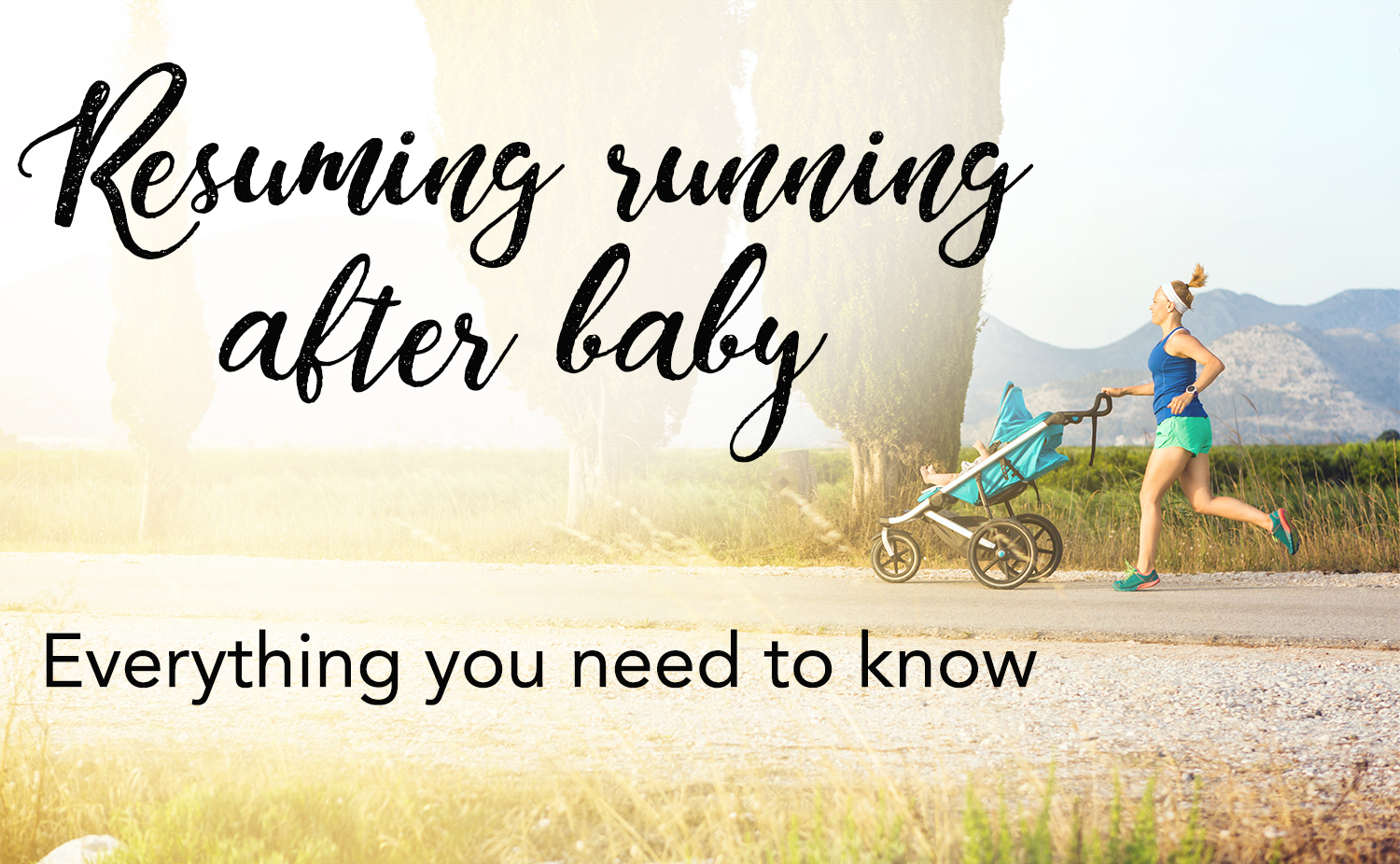“When can I run after giving birth?” - So many of my Postpartum Mamas reach out to me because they crave running – they crave feeling themselves, and how could we blame them!
Running can be incredibly freeing. What a great way to leave the house, breathe some fresh air, expend some energy and wake up those muscles after 9 long months of pregnancy. Not feeling like yourself and craving a good run is common for most active new Mothers. I perfectly remember wanting to return to the parts of my life that made me feel most like the old ‘ME’! Running was one of them, and I was dreaming of the day when I could finally take my baby for a run in the stroller.
Chances are you feel the same, so rest assured, you’ll get there! But right now, it’s important to acknowledge what your body endured and resist the urge to jump right back into running after pregnancy as if nothing happened… because so much has happened in the last few months!
There are a few things you need to know when returning to running postpartum. Don’t think that receiving the green light to exercise from your doctor means that you’re ready to do absolutely anything. This “green light'“ should come with a huge Asterisk . I personally recommend waiting at least 3 months before resuming jogging, but it’s important to remember you can find everything and it’s opposite online, so let’s clarify a few things so you can make the best decision for yourself!
1. Strengthen your core and pelvic floor before returning to running after having a baby
The Muscles and ligaments holding your organs and pelvis in place have stretched and weakened during pregnancy and delivery.
Running is a high-impact activity, so imagine that with each high impact step your organs are pushed forward against your stretched ab mid-line, and down low towards your weakened pelvic floor muscles. Remember that one of your pelvic floor functions is to be a shock absorber, but if it’s too weak to do its job, everything is pushed downward into your vagina. Resuming running after birth with a non-functional core and pelvic floor is the perfect scenario for a pelvic organ prolapse (bladder and uterus falling into the vagina – not fun!).
In order to return to running after birth safely you need to give your body the best opportunity to build up your core after pregnancy, core and pelvic floor exercises are essential. Without that strong stable core foundation you may experience lower back pain, pelvic pain, urinary incontinence, pelvic floor dysfunction or even pelvic organ prolapse. Your post pregnancy belly needs love! A solid core and elastic pelvic floor are essential to being able to run pain free and prevent potentially serious injuries from arising on down the road.
Core exercises to resume running postpartum - The Better Body after Baby Program
2. Running postpartum - Start progressively
Treat yourself as if you’ve been injured. If you tore knee ligaments, you wouldn’t start running right after a surgery. The same concept applies here, first you need to focus on your pelvic floor and ab re-education with postnatal exercise, then you can progressively make your way to postpartum running.
A great way to start is power walking.
Power walking is a much gentler form of cardiovascular exercise for you to begin with after childbirth with far less gravity puling on your joints and organs.
Session after session you can increase the duration and intensity of your walks to get back on track progressively. Then once you feel comfortable, you can start a walk-run program.
To do so, simply alternate one minute of running with one minute of walking for 20 to 30 minutes total. Stay in tune with your body and if that feels like too much start with 2 minutes walking and one minute of running. When you’ll feel ready you can progress to running for two minutes and walking for one for 20 to 30 minutes total.
Power walking - Resuming running postpartum
Simply start slow without a weekly mileage goal and make sure to take at least 1 rest day in between each session. Running on consecutive days can add more stress to the pelvic floor and lead to injury. Your pelvic floor needs to recover in between each run.
Remember: a single drop of urine is a drop too much, so be sure you don’t suffer from stress incontinence and if you do, take a few steps back and focus on your daily posture, abs, and pelvic floor reeducation.
3. Running postpartum - Know your hormones
After birth your body continues to release the hormone Relaxin for about 5 months, and even longer if you’re breastfeeding. As the name implies, this hormone relaxes the body's muscles, joints, and ligaments to prepare your pelvis to give birth. The Relaxin level in your system can affect your knee and hip alignment, as well as the ‘laxity’ (looseness) and strength of your pelvic floor, which is another reason why it is so important to follow an appropriate exercise regimen that will strengthen all the muscles in this area BEFORE you begin any high impact exercise.
Pregnancy and postpartum are perfect times to get to know your body and develop an awareness to feel if something is right or not. Pay attention to signals from your body. If you feel pain while running, especially in the back or hips, slow down. Research shows that postpartum back pain affects 75% of women… don’t ignore it.
I didn’t listen to my body after my first son. I went back to running after giving birth way too quickly. Ignoring my husband’s shaking head, I kept “trying” to run with no leak, I even ran Malibu’s Spartan race at 5 months PP. I leaked from the beginning of the race and it scared the s*** out of me. I finished in the top 20 women... I was proud, but deep inside I was terrified because knew I had done more damage. I got used to wearing black leggings (not showing the urine leak…) and paid the consequences with a dysfunctional diastasis recti, excruciating back pain and scary pelvic floor dysfunction for years… Don’t do the same, it’s definitely not worth it! This experience is what led me to educate myself under the finest pre and postnatal specialists in the US and Europe.
4. Running postpartum and breastfeeding
Breastfeeding and Running Postpartum
Research has shown that moderate exercise does not affect milk supply, milk composition, or baby’s growth. For your own comfort, you may wish to pump or feed your baby before exercising and wear a good, supportive bra. Doing so will also help avoid the potential bitter milk taste if lactic acid builds up in your body afterwards.
Some babies don’t like nursing when mom has been sweating (due to the salt on mom’s skin) so you may wish to rinse your breasts or take a quick shower before nursing. The most important thing is to keep hydrated before, during, and after exercising. Make sure to eat/drink a little snack after your workouts as well. Fast and healthy digesting proteins and carbs are best (I like Greek yogurts!).
For each mother, the type and frequency of exercise may be different, but the fact is that our bodies are meant to be in motion. Healthy mothers equal healthy babies.
My breastfeeding journey with Noa was longer than expected – 11 months. I loved it and I honestly miss this special time so much! However, a few weeks after the last breastfeeding session, I realized that I felt “different” during my run. I felt really good actually! No need for a pee-pee stop, I felt “solid”. Could it be linked with my lower relaxin production? Certainly!
5. Running postpartum - Can you run with a Diastasis Recti?
It depends, so let me explain.
If you are still in a recovery phase, trying to strengthen your core and pelvic floor, I would not recommend running for a few reasons. Due to the side to side shearing of the diastasis recti and high impact aspect of this activity, running puts too much stress on your healing linea alba and would very likely make the diastasis recti and pelvic floor issues worse. To repair itself, connective tissue doesn’t like to be under excessive strain. Running is not a safe exercise for a diastasis until you have strengthened and trained your core to handle it!
That where a second scenario is possible: If you’ve already been through a proper ab and pelvic floor reeducation, you may still have an ab separation but a strong core (you may have a functional diastasis recti). Your transverse and pelvic floor muscles may be strong enough to progressively resume running safely.
Again, listen to your body… and if you feel something is off, a heaviness, or any discomfort, stop running and refocus on your core. Progress is progress. Now is not the time to push yourself. You can find more info about Diastasis Recti exercises here.
6. Running postpartum - Hold off on the jogging stroller
Running Postpartum - Running with a stroller requires more advanced core strength
During pregnancy I was literally dreaming about running post pregnancy! A jogging stroller was one of the first pieces of gear we bought when I was pregnant for the first time. I was so looking forward to cruising around with my babe! Well, I don’t want to disappoint you, but… as tempting as it can be to get the stroller out of the garage and bring baby for a little run, it’s commonly recommended to wait until they are about 8 months old.
Babies need enough strength and neck control before being taken out for a run. The right time will come! In the meantime, take the baby out for a walk in your jogging stroller – My babes and I loved the Bob Revolution SE!
Also, your baby isn’t the only one that’s not ready for it. Running with a stroller requires more advanced core strength, so focus on stroller walks to breathe some fresh air, leave the house, get moving, and stimulate your baby with the outdoors!
Running postpartum can be a great way to bond with your baby – once you’re both ready. So allow some time for you and your baby to build strength before returning to running after pregnancy.
Looking to get rid of your post pregnancy belly and improve your pelvic floor function
Running Postpartum
Learn from my mistakes
Resuming running after pregnancy is a journey! Try to be patient and trust in your body and give it the best chance to recover quickly and properly.
I know all too well the desire to rush back into running postpartum. Believe me, I’ve been there twice.
The 1st time I did rush and made countless mistakes, I was so anxious to get "my body back", to “feel myself again”… and I paid the price. I unknowingly caused injuries that took 3 years to recover from! Back pain, ab separation and stress incontinence were part of my daily life!
This painful journey led me to educate myself with the best Coaches, Physiotherapists, and Doctors, so the 2nd time around I was reasonable and respectful with my body. I healed entirely in a few months and even managed to recover from the damage done previously.
Gently and progressively returning to running after baby and exercises is key to recovering properly. Your body needs a few months to heal – you’ll have the rest of your life to run around!





